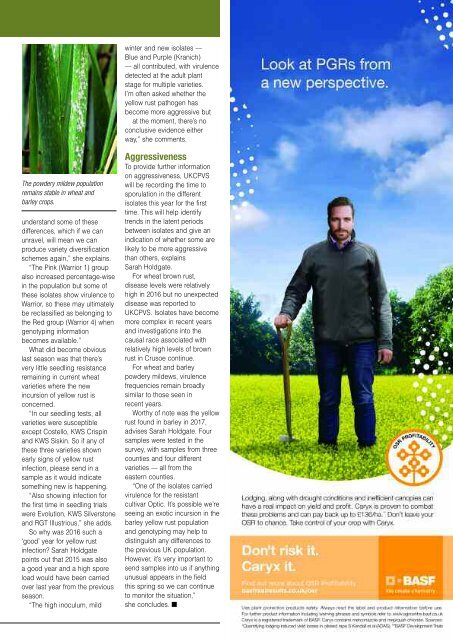In this issue..
CPM-March-Extra-2017
CPM-March-Extra-2017
You also want an ePaper? Increase the reach of your titles
YUMPU automatically turns print PDFs into web optimized ePapers that Google loves.
winter and new isolates ––<br />
Blue and Purple (Kranich)<br />
–– all contributed, with virulence<br />
detected at the adult plant<br />
stage for multiple varieties.<br />
I’m often asked whether the<br />
yellow rust pathogen has<br />
become more aggressive but<br />
at the moment, there’s no<br />
conclusive evidence either<br />
way,” she comments.<br />
The powdery mildew population<br />
remains stable in wheat and<br />
barley crops.<br />
understand some of these<br />
differences, which if we can<br />
unravel, will mean we can<br />
produce variety diversification<br />
schemes again,” she explains.<br />
“The Pink (Warrior 1) group<br />
also increased percentage-wise<br />
in the population but some of<br />
these isolates show virulence to<br />
Warrior, so these may ultimately<br />
be reclassified as belonging to<br />
the Red group (Warrior 4) when<br />
genotyping information<br />
becomes available.”<br />
What did become obvious<br />
last season was that there’s<br />
very little seedling resistance<br />
remaining in current wheat<br />
varieties where the new<br />
incursion of yellow rust is<br />
concerned.<br />
“<strong>In</strong> our seedling tests, all<br />
varieties were susceptible<br />
except Costello, KWS Crispin<br />
and KWS Siskin. So if any of<br />
these three varieties shown<br />
early signs of yellow rust<br />
infection, please send in a<br />
sample as it would indicate<br />
something new is happening.<br />
“Also showing infection for<br />
the first time in seedling trials<br />
were Evolution, KWS Silverstone<br />
and RGT Illustrious,” she adds.<br />
So why was 2016 such a<br />
‘good’ year for yellow rust<br />
infection? Sarah Holdgate<br />
points out that 2015 was also<br />
a good year and a high spore<br />
load would have been carried<br />
over last year from the previous<br />
season.<br />
“The high inoculum, mild<br />
Aggressiveness<br />
To provide further information<br />
on aggressiveness, UKCPVS<br />
will be recording the time to<br />
sporulation in the different<br />
isolates <strong>this</strong> year for the first<br />
time. This will help identify<br />
trends in the latent periods<br />
between isolates and give an<br />
indication of whether some are<br />
likely to be more aggressive<br />
than others, explains<br />
Sarah Holdgate.<br />
For wheat brown rust,<br />
disease levels were relatively<br />
high in 2016 but no unexpected<br />
disease was reported to<br />
UKCPVS. Isolates have become<br />
more complex in recent years<br />
and investigations into the<br />
causal race associated with<br />
relatively high levels of brown<br />
rust in Crusoe continue.<br />
For wheat and barley<br />
powdery mildews, virulence<br />
frequencies remain broadly<br />
similar to those seen in<br />
recent years.<br />
Worthy of note was the yellow<br />
rust found in barley in 2017,<br />
advises Sarah Holdgate. Four<br />
samples were tested in the<br />
survey, with samples from three<br />
counties and four different<br />
varieties –– all from the<br />
eastern counties.<br />
“One of the isolates carried<br />
virulence for the resistant<br />
cultivar Optic. It’s possible we’re<br />
seeing an exotic incursion in the<br />
barley yellow rust population<br />
and genotyping may help to<br />
distinguish any differences to<br />
the previous UK population.<br />
However, it’s very important to<br />
send samples into us if anything<br />
unusual appears in the field<br />
<strong>this</strong> spring so we can continue<br />
to monitor the situation,”<br />
she concludes. ■


